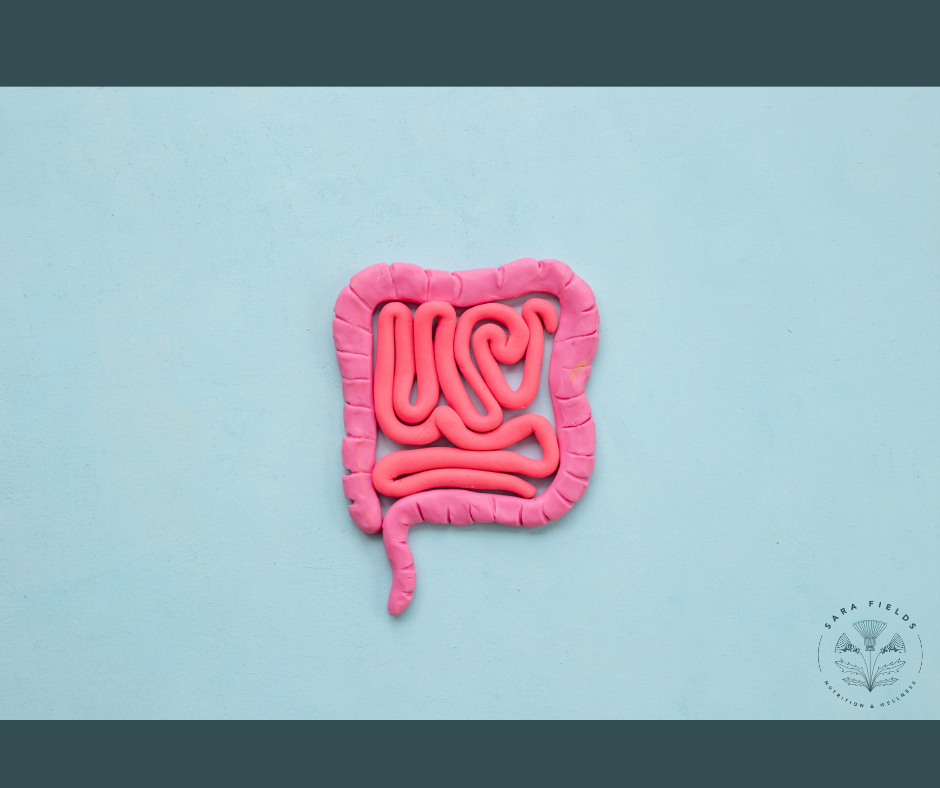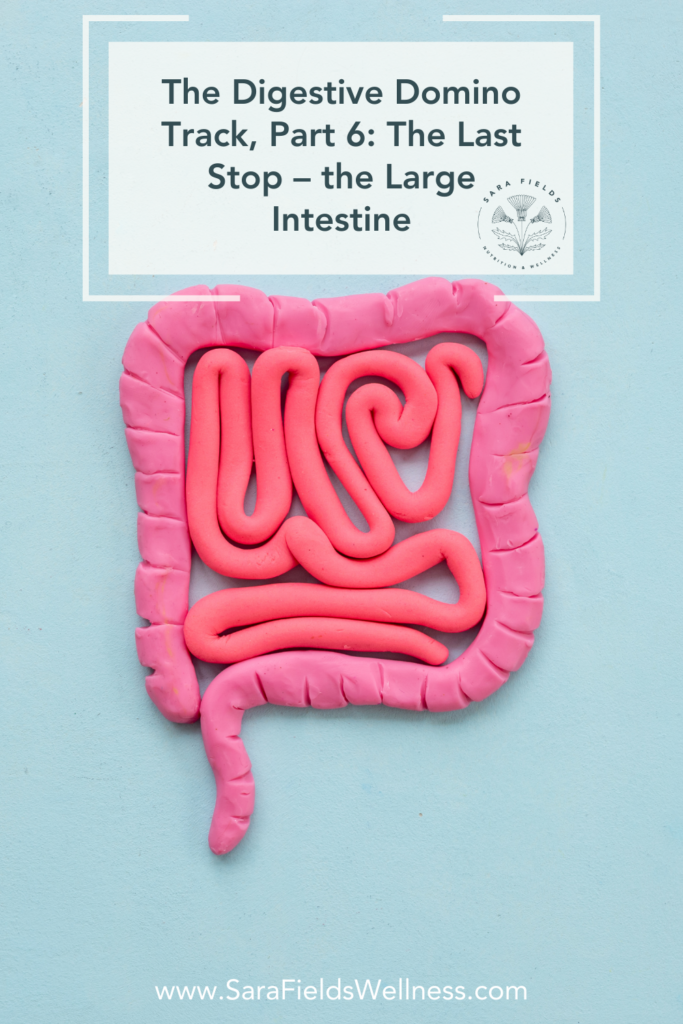
In the last five parts of this series, we have been traveling organ by organ through the digestive system, and we’ve finally made our way to our last stop: the lesser-celebrated, yet absolutely vital segment of our digestive system – the large intestine.
Just like we have before, we’re covering three things: what this organ does, how things go wrong here, and what actions we can take to improve the health of this “domino” and any related symptoms.
What does the large intestine even do?
After our food has been mashed, mixed, and broken down in the stomach and small intestine, it reaches the large intestine in a semi-liquid state. Here, the large intestine works its magic, absorbing water and electrolytes, compacting the material, and transforming the mixture into a more solid form (AKA poop!). You didn’t think we’d get through this series without talking about poop, did you? 😂The water absorption is crucial to maintaining our body’s hydration levels and ensuring our waste material is just the right consistency for elimination. The large intestine then stores this material until it’s time for a bathroom visit. This step is crucial for removing undigested food particles, bacteria, and other waste products from the body.
The large intestine is also home to the majority of our gut microbiome, which is made up of trillions of bacteria that play essential roles in digestion. They ferment undigested carbohydrates, producing short-chain fatty acids (SCFAs). These fatty acids not only nourish the cells lining the colon but also have systemic benefits, including anti-inflammatory properties, metabolism-regulating impacts, and potential protective effects against diseases like colorectal cancer. They also synthesize certain vitamins like K and B12, adding to our nutrient levels.
What happens when things go south in the large Intestine?
While those gut bacteria I mentioned above are usually helpful, an overgrowth of certain types can lead to problems like bloating, gas, and discomfort, as excess bacteria ferment foods inappropriately.
When the large intestine absorbs too much water or its muscular contractions slow down, it can result in constipation, which can also cause bloating, abdominal pain, and hard stools that are difficult to pass.
A less often discussed consequence of dysregulation in the large intestine is that some gut bacteria produce an enzyme called beta-glucuronidase, which can separate used up estrogen from the material it was bound to for its exit out of the body via a bowel movement. This process reactivates estrogen, leading to its reabsorption into the bloodstream, potentially contributing to hormone imbalances and conditions like estrogen dominance.
And, lastly, probably the most known consequence of things gone awry in the large intestine are conditions like Irritable Bowel Syndrome (IBS) and Inflammatory Bowel Disease (IBD), including Crohn’s disease and ulcerative colitis. These involve inflammation of the colon and can cause pain, diarrhea, and other severe digestive symptoms.
How do we right what’s wrong in the large intestine?
There are two important things to preface this section with, and those are:
1) As with all other digestive issues, there is no one-size-fits-all solution and what drives one person’s symptoms will almost certainly not be the same for the next person. This is why an individual and data-driven approach is so important when you’re trying to get to the root of things!
2) Being all the way down here at the end of the Digestive Domino Track, we have to look all the way back up to understand how those earlier dominoes might be affecting what’s happening in the large intestine. Remember, one thing affects the next, affects the next, and so on!
With those things out of the way, here are some things we have to consider when it comes to the optimal health and function of the large intestine:
- Fiber – We’ve probably all heard how important fiber is for the gut, which is very true! Soluble fiber (found in oats, apples, and beans) forms a gel-like substance that can help soften stools and ease their passage. Insoluble fiber (found in whole grains and vegetables) adds bulk to stools, promoting regular bowel movements. However, for some individuals, especially those with IBS, increasing fiber intake—particularly certain types—can exacerbate symptoms like bloating and gas. It’s crucial to personalize fiber intake based on individual tolerance and digestive health.
- Probiotics and Prebiotics – Probiotics, found in fermented foods like yogurt, kefir, sauerkraut, and my favorite, kimchi, introduce beneficial bacteria to your gut. Prebiotics, found in foods like garlic, onions, and bananas, feed these good bacteria. Together, they help maintain a balanced gut microbiome. However, those with sensitive digestive systems might need to introduce these foods slowly, as they can sometimes cause discomfort initially.
- Omega-3 Fatty Acids – These fatty acids are found in foods such as salmon, sardines, chia sees, and flaxseeds. They have anti-inflammatory properties that can help reduce inflammation and associated discomfort in conditions like IBS and IBD.
- Water – Staying well-hydrated is crucial for preventing constipation. In fact, it’s the first question I ask my clients when they share that they’re feeling a bit backed up. Water helps keep stools soft and supports the overall function of the digestive system. Proper hydration also aids in the effectiveness of fiber, making it easier for the large intestine to process and eliminate waste.
- Magnesium – When hydration and fiber aren’t moving things along, magnesium supplements can help promote smoother bowel movements and alleviate constipation. Magnesium citrate, in particular, has a laxative effect, can be super helpful. Taking the magnesium at night can yield a complete bowel movement the following morning, and as a bonus, it can also improve sleep.
- Gut soothing ingredients – There are several herbs and other ingredients that are known to help soothe the large intestine and reduce digestive discomfort – peppermint, ginger, turmeric, and aloe are a few of these.
- Food Sensitivities – Identifying and managing food sensitivities can be incredibly helpful for large intestine health. Common culprits like gluten, dairy, and certain fermentable carbohydrates (FODMAPs) can cause significant distress. An informed elimination diet, (AKA an elimination diet that is guided by food sensitivity testing) can help pinpoint specific trigger foods that, when removed for a period of time, can help reduce inflammation and other digestive symptoms. It’s important to note that sensitivities can vary greatly between individuals, so testing and personalization is key.
- Lastly – here’s where we tie the whole darn thing together, friends – when considering ways to improve large intestine health and reduce symptoms, we must consider the impact of digestive health further north… the domino effect! The health of the large intestine is intricately connected to the functioning of all of the digestive system above it.
Consider that adequate stomach acid is essential for breaking down proteins and killing harmful bacteria before they reach the intestines. Proper pancreatic enzyme production ensures that fats, carbohydrates, and proteins are effectively digested in the small intestine, reducing the burden on the large intestine. Bile, produced by the liver and stored in the gallbladder, emulsifies fats for digestion and also helps eliminate waste products from the liver. When any of these processes falter, the large intestine can suffer.
So as we conclude this 6-part series on the Digestive Domino Track, by understanding the key digestive system functions, recognizing potential issues, and adopting supportive dietary, lifestyle, and supplemental strategies, we can ensure that our digestive system runs smoothly from start to finish. And, what’s more, because of this, we have a better chance of improving our overall health!

I have really found this information helpful. Thank you for providing this very interesting information. Great job Sara.